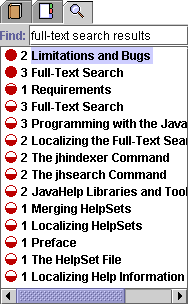
The JavaHelp system full-text search engine uses a natural language search technology that not only retrieves documents, but locates specific passages within those documents where answers to queries are likely to be found. The technology involves a conceptual indexing engine that analyzes documents to produce an index of their content and a query engine that uses this index to find relevant passages in the material.
As the help author, you create the search database that is searched by the JavaHelp system full-text search engine. The process of creating the search database is described in Creating the Full-Text Search Database.
To initiate a search the user enters a natural language query in the search navigator Find text box. The results are reported back to the user in the following display:

![]()
To avoid confusion, be sure the <TITLE> tag
corresponds to the title used in the table of contents.
The search engine uses a technique called relaxation ranking to identify and score specific passages of text that are likely to answer the user's query. The relaxation ranking algorithm compares the user's query terms with occurrences of the same or related terms in the help topics. The search engine attempts to find passages in the help topics in which as many as possible of the query terms occur in the same form and the same order. The search engine automatically relaxes these constraints to identify passages in which:
![]()
The ranking process improves when queries are more
complex and include more information.
The JavaHelp search engine uses "morphing" technology to find words with common roots. For example, when the term "build" is included in a search string, matches that contain "built", "builder", "building", and "builds" are returned.
![]()
In the 1.0 release, the morphing feature is only available for the
Engish (en) locale.
![]() See also:
See also: